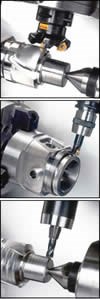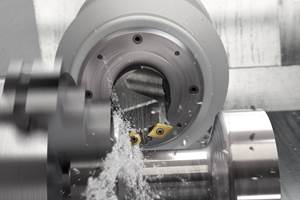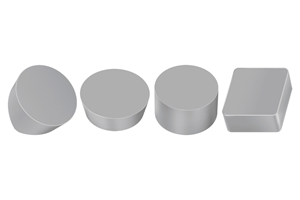Applying Turn-Milling
Combining a rotating tool with rotating work produces a machining operation that is distinct from standard turning or milling.
Share





"Turn-mill" can be an ambiguous term. Turning centers with rotary-tool capability are sometimes called turn-mill machines. But at the same time, there is a specific metalworking operation performed on these machines that rightly deserves to be called "turn-milling." This involves cutting with a rotating milling tool while the workpiece is also rotating.
There are many reasons why a shop might want to machine this way. Chip control is one. Dealing with interrupted cutting is another. At least one cutting tool supplier—Sandvik Coromant—now sees turn-milling employed so frequently that the company has developed cutting tools specifically for this operation. Sandvik product specialist Jim Grimes, who provided the information for this article, says that with sophisticated multitasking lathes coming into greater use, turn-milling can no longer be thought of as such an unusual way to cut. Today's users of turn-mill machines should be thinking about this style of cutting in many cases where they struggle with standard turning.
When To Turn-Mill
Here are some of the specific challenges that turn-milling can address:
- High metal removal. If a turned part requires a lot of material to be removed, turn-milling may be able to do this more efficiently.
- Interrupted cuts. Turning tools tend not to do well in interrupted cutting, but a milling tool can fare much better. A milling cut is already an interrupted cut by definition. In the region of the workpiece where the cut becomes interrupted, it may make sense to switch from turning to turn-milling.
- Stringing chips.The "bird's nest" produced by the stringing chip in some materials won't build up when the part is turn-milled instead of turned. One consequence of milling's inherently interrupted cut is that chips are cut into small pieces.
- Flexible shafts. When the turned part is long, slender and not braced in the middle, turn-milling may prevent it from deflecting. Compared to turning, milling can remove the material with less tool pressure.
- Tool life. In a hard-to-machine metal, a single turning insert might not be able to deliver enough tool life to last to the end of the cut. A milling tool can cut longer, because it has multiple inserts to divide the load. By enduring the complete cut, the milling tool can eliminate the risks involved with changing tools in mid-operation.
- Eccentric diameters or odd shapes. The radial (X-axis) motion of the milling cutter can be coordinated with the rotation of the workpiece to machine profiles other than perfect circles. Sandvik itself uses this technique to rough-machine the three-lobed, tapered shape of its "Capto" toolholders. The same principle—the milling cutter moving in and out while the workpiece turns—can also be used to generate off-center features without having to change the setup. The off-center pin on a crankshaft could be an example of this.
Turn-Milling Technique
Turn-milling is not particularly demanding of the machine tool, but at minimum the process does require Y-axis motion.
Workpiece rotation provides the C-axis motion that delivers the desired feed rate for the milling cutter. Instead of sfm, in other words, the rotation speed is chosen for a particular ipm. (That means the workpiece speed in turn-milling is much slower than what is typical of turning.)
Y-axis motion is needed because the milling cutter has to do most of its cutting off-center. The tool can't machine the part to size when it is on-center—when the tool centerline intersects with the axis of rotation of the part—because then the tool would be cutting on the center of its face and not on its edges. To ensure that the cutting edges cut properly, the tool centerline should be offset from the work's axis of rotation by 1/4 of the cutter diameter.
The problem with cutting this way occurs when the tool reaches a shoulder or the side of a groove. The off-center tool leaves a rounded corner behind.
To achieve a sharp corner, the cutter must take a second pass. The offset is eliminated, so the tool moves back to the on-center position in Y. This second pass performs no material removal except for what is necessary to clean the corner material away.
One fact of life in turn-milling is form error. Milling around the circumference of a round form inevitably leaves regularly spaced scallops in the surface. This error can't be eliminated altogether, but it can be controlled using wiper inserts. A wiper insert is an insert that follows along behind the cutting edge, extending just a little farther into the material to smooth out the freshly cut surface.
Mr. Grimes says his company's development of tools for turn-milling has focused on wiper design. The wiper makes the scallop error controllable, because formulas associated with a particular wiper let users adapt their turn-milling parameters to achieve whatever level of error is acceptable.
Force And Deflection
One wiper-equipped tool is a solid-body end mill that gets its wiper effect from having two of the four flutes reach deeper into the part. A secondary benefit of this tool design is that it redirects the cutting force in a beneficial way. In turn-milling, as the work rotates up to meet the tool, some of the cutting force pushes along the tool's axis. Having only two active flutes on the bottom reduces this axial component of force, so more of the cutting force is pushing in the tool's radial direction.
The fact that this change is beneficial points out how different turn-milling is from milling in general. In a more standard milling application, sending force along the tool's axis can be good. The work is well supported in this direction. But in turn-milling, where the work may be long, slender and supported only at the two ends, it is the tool's axial direction that presents the greater risk of harmful chatter. Making the best use of forces in this application calls for an altogether different design of the tool.
Related Content
Sandvik Coromant Turning Tools Enable Y-Axis Turning
The company has developed two new tools to support Y-axis turning: CoroTurn Prime and the CoroPlex YT twin-tool.
Read MoreWalter Ceramic Inserts Enable Efficient Turning, Milling
Suitable turning and milling applications of the WIS30 ceramic grade include roughing, semi-finishing and finishing, as well as interrupted cuts.
Read MoreKyocera Turning Grade Provides Tough Cutting Edge
The Megacoat Tough coating combines a wear-resistant layer on the surface adhered to high-content CBN, which provides greater fracture resistance when encountering interruptions.
Read MoreKennametal Turning Tools Enhance Small Part, Medical Machining
TopSwiss Micro Boring Solid tooling and KCU25B turning inserts are well suited for the small parts and medical machining space.
Read MoreRead Next
Building Out a Foundation for Student Machinists
Autodesk and Haas have teamed up to produce an introductory course for students that covers the basics of CAD, CAM and CNC while providing them with a portfolio part.
Read MoreSetting Up the Building Blocks for a Digital Factory
Woodward Inc. spent over a year developing an API to connect machines to its digital factory. Caron Engineering’s MiConnect has cut most of this process while also granting the shop greater access to machine information.
Read More5 Rules of Thumb for Buying CNC Machine Tools
Use these tips to carefully plan your machine tool purchases and to avoid regretting your decision later.
Read More

































